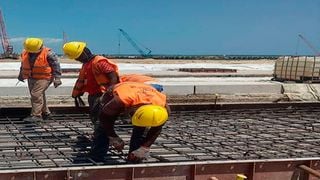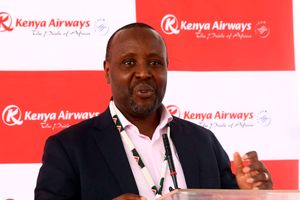
Lapsset workers on site in Kililana in Lamu West in 2018.
News
Premium
Kenya seeks investors in bid to complete Lapsset projects
Kenya has spent more than Sh157 billion on projects along the Lamu Port-South Sudan-Ethiopia-Transport (Lapsset) Corridor in the last decade, the Nation has learnt.
The government now wants to work with private partners to complete the projects that are expected to revolutionise trade in the region.
The Lapsset corridor will have a railway, a highway, a crude oil pipeline and a fibre-optic cable connecting the three countries. It will also include several airports, resort cities, an oil refinery and a 32-berth port in Lamu.
President Uhuru Kenyatta is set to officially open three berths in May, when Ethiopia and South Sudan are expected to start using the facility.
Three years after Kenya, Ethiopia and South Sudan committed to use crowdfunding to raise the billions of shillings required to build infrastructure linking their economies to the corridor, the agreement is yet to be implemented.
Lapsset Corridor Development Authority (LCDA) chairperson Titus Ibui told the Nation yesterday that security challenges in Lamu County were posing a serious challenge to the progress of the projects.
Mr Ibui said there was a need to mobilise more funds and improve on security to ensure the projects are completed in time to make them more viable to the region.
Speaking during a stakeholders’ meeting in Mombasa, Mr Ibui said a number of projects had stalled due to insecurity. Some contractors have suspended works until they are assured of their safety.
Last month, the China Communications Construction Company Limited (CCCC) withdrew its staff in Lamu County after eight vehicles, including trucks and excavators worth more than Sh41.98 million, were destroyed by suspected al-Shabaab militants. The equipment was being used in the construction of the Sh17.9 million Lapsset Corridor Project access road.
He said the Kenyan government has fully funded all the projects, contrary to the agreement with state countries within the corridor to do crowdfunding, which was signed in 2020.
In a memorandum of understanding (MoU) signed by ministers in the Lapsset implementing states to speed up progress, the states agreed on joint budgetary allocation to ensure the projects are completed on time.
They also pledged to harmonise regulations and run joint marketing for the project. The 453km Lapsset Development Road project network began in April last year and was estimated to take 24 months.
It comprises the 257km section of the Lamu-Ijara-Garissa road and a further 113km, which is the Hindi-Bodhei-Basuba-Kiunga road. It also entails the construction of the 83km Ijara-Sanghailu-Hulugho section.
Several projects have been hit by delays and security challenges. They include the construction of a port, power plant, railway and other facilities from the Lamu port, through to South Sudan and Ethiopia.
The construction of the first phase of the second commercial port in Kenya at Lamu has been completed at a cost of Sh40 billion.
The second and third berths were completed in December last year, giving Kenya the opportunity to float a tender to private companies to construct 20 more berths under Public Private Partnership, to complete the 23-berth facility.
Since its launch in May last year, the port has handled nine vessels and a total of 1,619 twenty feet-equivalent units (TEUs) in its first berth, according to Kenya Port Authority database.
Lapsset seeks to link the three states via rail, airports, roads and oil pipelines. Under the project, Lamu is set to become Eastern Africa’s largest seaport with 23 berths.
According to the new plan, it will be implemented in two phases under the East-West Beltway corridor and land bridge. The project’s adoption by the AU gives it sufficient mileage and exposure to attract foreign direct investment (FDI).





